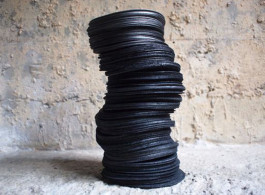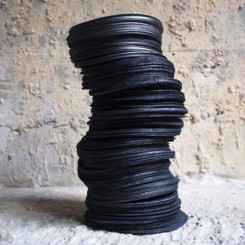FOST Gallery is pleased to present the truth of matter* by Grace Tan.
This body of work marks a new juncture in the development of Tan’s earlier kwodrent series beyond the formalistic aspects of rectangles characterised by the earlier fabric-based works. The paper and pigment constructions are a result of an attempt to seek deeper dialogues with the materiality of the chosen media. At the same time, they look back to the origins of the kwodrent series by staying true to the fundamental ethos of working intuitively with the hands, to allow the medium to guide and formulate new methods in the process.
Tan’s current exploration focuses on the textural and optical effects of artist pigments. Instead of mass produced and readymade colourants, she uses significant pigments with historic relevance from all over the world like Ultramarine Ash (lapis lazuli mined from Afghanistan), Bianco San Giovanni (limestone from Italy), Matsubarokusho (Japanese Nihonga malachite pigment mined from China), Gofun (levigated oyster shells from the Inland Sea, Japan) and carbon-based pigments such as graphite, charcoal and Sumi (soot ink from Japan). Her works provide a critical and intriguing insight into the nature and account of these materials. Many of the pigments used can be traced back to naturally occurring minerals formed over an extensive period of time while others have been painstakingly made according to ancient recipes. For example, Ultramarine Ash is the by product of the extraction of natural ultramarine from lazurite, the distinctive vivid and clear purplish blue pigment often reserved for painting the robes of the Virgin Mary and infant Christ in Renaissance religious images. The procedure is based on the principle method of a 14th century historic recipe recorded by Cennino Cennini. The final extraction known as Ultramarine Ash contains the least and smallest blue particles with a high proportion of colourless crystalline materials and it is valued as a pale blue glazing pigment.
In most of the works, Tan uses sculptural stacks of 300gsm mould-made watercolour paper to receive these pigments. It consists of pure cotton rag that is recognised for its structural stability, pliability and texture. The paper is subjected to various techniques and hand finishes to bring out its nuances and properties. For example, straight lines cut precisely 1 to 2 mm apart, using a sharp penknife at an angle and ruler, create curved strips similar to curly wood shavings, an effect caused by the deformation and stretching of the strip. Some works have surfaces that are sanded, scraped or brushed to create different intensities of textures while others are intentionally torn and cockled to distort the uniformity of the machine-made sheets. Tan also uses thin bamboo pulp calligraphy paper (Chinese xuanzhi) known for its tensile strength and tactility to bring out its softness and fragility.
Adopting a tabula rasa approach to these pigments, Tan strips away traditional associations and applications, allowing each pigment to lead in the formation of the works. This approach to the raw materials creates an intimate connection between her and the medium, heightening the sense of being and participation in the journey leading to the materialisation and realisation of the works. She describes a part of her working process, “Very often, it is about staying still, to observe and to wait - for the pigments to be saturated with nikawa [cow hide glue, made in Japan] and to dry out, for a work to emerge, for an encounter or for an interjection”.
The investigation alludes to the notion of respiration or qi – an unobjectifiable quality seen in Chinesel and scape painting where forms unfold, alternating between the visible and invisible in a constant flux of renewal to create life-force. In similar manner, these works as studies of formal and textural constructions are embodiments of the selected materials and the process of them coming together and becoming something. It is in this movement of going back to the hidden source and becoming that the essence of matter is revealed and experienced. the truth of matter is therefore about the essence of things; a kind of nebulous quality and deep beauty when materials reveal themselves. This is the second solo exhibition by Grace Tan presented at FOST Gallery, the first was in 2008.
About the Artist
Grace Tan (b. 1979, Malaysia) is a multi-disciplinary artist whose works often blur the lines between design and art. Formally trained in fashion design, Tan began her art and design practice in 2003 under the kwodrent studio in which she presented a series of works based on the study of rectangles, materials, and construction methods. The series is defined and shaped by an intuitive and methodological working process where each piece of work is numbered and dated to form a chronological record of the series’ development. In recent years, her works have evolved beyond wearable fabric pieces into complex site specific installations and spatial constructs, while retaining the core method-based working process.
Tan has been commissioned by the Singapore Art Museum, The Esplanade and the Land Transport Authority of Singapore. She has also represented Singapore at Singapore Biennale 2013, Fukutake House/Setouchi Triennale 2013 (in collaboration with The Substation), Aichi World Expo 2005, Venice Architecture Biennale 2008, London Design Week 2006 and State of Design Melbourne 2008-2010. In 2012, Tan was awarded the distinguished President’s Design Award for Building as a Body and in 2013, she was conferred the Young Artist Award and nominated for the President’s Young Talents Award. Tan lives and works in Singapore.
About Gillman Barracks
Gillman Barracks is a new contemporary art destination in Singapore. Nestled amid lush greenery, this former colonial barracks is now home to local and international art galleries, dining, and creative businesses, as well as the Centre for Contemporary Art (CCA). The CCA seeks to enhance the region’s contemporary art landscape through its international artist residency, research and exhibition programmes.
For more information, visit please www.gillmanbarracks.com






